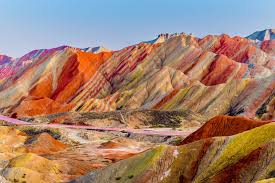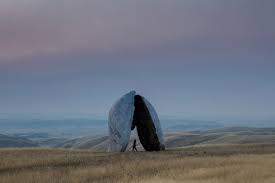
Zhangye National Geopark, China stuns with its rainbow mountains. Discover 7 breathtaking reasons this colorful landscape should top your travel list.
1. A Natural Canvas of Colorful Sandstone
Zhangye National Geopark, China, often called the “Rainbow Mountains,” is a geological masterpiece painted by nature over millions of years. The park’s signature multicolored rock formations appear as though brushed by a divine artist—layers of deep red, orange, yellow, and green striations stretch across rolling hills and jagged cliffs. These stunning colors are the result of red sandstone and mineral deposits layered over time and shaped by wind and water erosion.
This vibrant display makes Zhangye Danxia one of the most photogenic locations in the world. As light changes throughout the day, so do the colors of the landscape, offering photographers and travelers a truly dynamic experience. The surreal terrain looks almost otherworldly, drawing comparisons to landscapes found in science fiction movies.
2. Unique Geological History and UNESCO Recognition
The captivating formations of Zhangye National Geopark, China, are part of the larger Danxia landform, a rare type of landscape found only in China. These formations date back over 24 million years, offering visitors a rare glimpse into Earth’s geological history. The distinct layering is a visual record of tectonic plate shifts and climate changes that occurred over millennia.
Recognized by UNESCO as a World Heritage Site, this geopark is not only visually spectacular but also of significant scientific importance. Researchers from around the world visit the site to study its complex geological layers and learn more about Earth’s evolution. It’s a location where natural beauty meets scientific curiosity, making it an essential stop for eco-tourism.
3. Panoramic Viewpoints and Scenic Walkways
Zhangye National Geopark, China, is designed to maximize visitor experience while preserving the environment. A series of elevated walkways and well-placed viewing platforms provide stunning panoramic views of the landscape without disturbing the natural terrain. These platforms are strategically located to showcase the most colorful and dramatic vistas, especially at sunrise and sunset when the colors are at their most vibrant.
Visitors can walk or take park shuttle buses between the platforms, making the experience accessible to all levels of travelers. Clear signage and informative boards also enhance the educational experience, explaining the park’s unique geology and the processes behind the mesmerizing formations.
4. Ideal Times to Visit for the Best Views
Timing your visit to Zhangye National Geopark, China, is key to seeing its colors at their peak. The best time to visit is between June and September when the summer sun enhances the saturation of the rocks. Early morning and late afternoon are ideal for photography, as the slanted sunlight adds depth and contrast to the vibrant bands of color.
Spring and autumn are also excellent choices for avoiding the tourist crowds while still enjoying moderate temperatures. The weather during these seasons allows for comfortable hiking and sightseeing, and the park’s expansive vistas remain just as awe-inspiring.
5. Rich Cultural Backdrop and Local Experiences
While the geological formations are the main draw, Zhangye is also rich in culture and history. Located in Gansu Province, the area was once a vital stop on the ancient Silk Road. Visitors can explore nearby temples, such as the Giant Buddha Temple, home to China’s largest indoor reclining Buddha statue, or enjoy local food markets offering regional delicacies like hand-pulled noodles and beef dishes.
Engaging with local culture adds depth to the trip, allowing travelers to appreciate not just the natural beauty of Zhangye National Geopark, China, but also its human history and traditions. Local guides often enrich tours with folk stories and insights into the area’s heritage.
6. Photography Paradise and Travel Tips
Photographers flock to Zhangye National Geopark, China, for its stunning compositions and dramatic lighting conditions. Wide-angle shots, drone footage (where permitted), and panoramic captures are all common ways to do justice to this remarkable terrain. If you’re planning to photograph the landscape, consider bringing a polarizing filter to reduce glare and enhance contrast.
When visiting, it’s wise to wear comfortable shoes, bring sunscreen, and carry water—despite the altitude, the dry climate can be intense. Drone usage may require permission from local authorities, so check the latest guidelines before arriving. Booking a tour with a local guide can also enhance the experience, especially for first-timers.
7. Sustainable Tourism and Preservation Efforts
Zhangye National Geopark, China, balances visitor access with conservation through strict management practices. By directing tourists to specific pathways and platforms, the park minimizes environmental degradation while maximizing enjoyment. Recycling stations, educational signage, and regular maintenance reflect a strong commitment to sustainability.
Efforts are continually made to preserve the area’s natural beauty for future generations. Visitors are encouraged to follow Leave No Trace principles, respect park guidelines, and support local businesses that prioritize eco-friendly practices. By being responsible travelers, we contribute to the park’s long-term protection.
Final Thoughts: Why Zhangye National Geopark, China Deserves a Spot on Your Bucket List
Zhangye National Geopark, China, is a breathtaking fusion of vivid colors, rare geological formations, and cultural richness. Whether you’re a nature lover, photographer, history enthusiast, or simply someone in search of awe-inspiring landscapes, this destination has something extraordinary to offer. With its accessible viewpoints, educational value, and emphasis on sustainable tourism, it’s not just a place to visit—it’s a place to remember.
Don’t miss the opportunity to witness one of the Earth’s most extraordinary landscapes. Plan your trip to Zhangye National Geopark, China, and prepare to be amazed by nature’s artistry.






